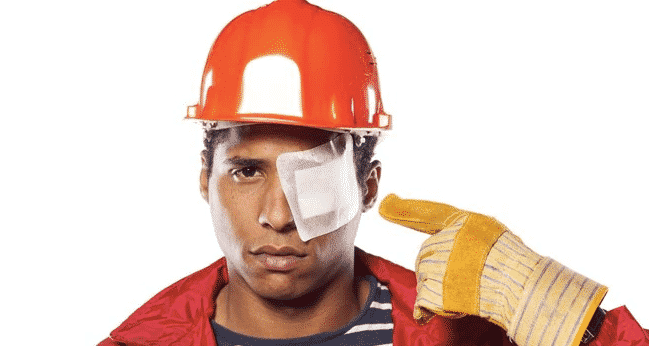Occupational eye injuries happen more often than you think. More than 2,000 workers sustain an eye-related injury on the job every day according to the National Institute for Occupational Safety and Health (NIOSH). Of these injuries, 10 to 20 percent result in temporary or permanent vision loss that could change the course of a worker’s life forever.
Experts believe that 90 percent of occupational eye injuries can be prevented just by using certified and approved protective eye equipment. The American Optometric Association reports that workers experience eye injuries most commonly from not wearing any protective eye equipment or not wearing the right type for their job. In addition to the painful physical consequences of an eye injury, about 1 in 10 eye-related accidents require one or more missed workdays to recover. These unnecessary injuries not only cost workers a loss in wages, but can also lead to expensive medical bills, surgeries, the need for customized eyewear, and other long-term treatment costs depending on the severity of the damage.
To help spread awareness about the importance of wearing appropriate eye protection on the job, March is Workplace Eye Wellness Month. As spring approaches, it is the perfect time to educate employers and employees on the specific hazards in their work environment that can lead to eye-related accidents and remind them how to reduce the number of injuries by using protective eye equipment in the future.
Eye Hazards Are Everywhere
No workplace is immune to eye hazards. Industries posing the most threat to worker’s eyes include construction, welding, woodworking, and other manufacturing positions that work with chemicals, foreign particles, and extreme heat. However, even office occupations can cause strain and injury to the eyes if safety precautions are not taken.
These are just a few of the eye hazards employers should be watching for when monitoring employee eye safety at work:
- hazardous chemicals (acids, corrosive substances, fuel, other harmful gasses);
- metal shavings and molten metal;
- wood chips and sawdust;
- dirt or sand;
- cleaning supplies;
- paint and stains;
- bright lighting or prolonged exposure to light;
- radiation; and
- glass or plastic particles.
In addition to the harmful particles and materials a worker could be exposed to, rouge tools and flying objects can easily hit someone in the eye and cause severe trauma without any eye protection as a barrier.
Why Employees Don’t Wear Protection
The best protection against occupational eye injuries is protection that employees will wear. Several reasons for why employees may not be wearing protection on the job include:
- discomfort;
- irritation;
- impaired vision;
- scratched or damaged equipment;
- under or oversized equipment;
- underestimating hazards;
- feeling unfashionable; and
- employer is not providing eye protection.
Wearing just any eye protection on the job will not help prevent eye-related accidents. Protective eye equipment must be approved, certified, and in good condition to protect workers. Eye protection that is cheaply made or already damaged can break and lead to further injury to the eyes. Eye protection not durable enough to protect workers from the specific hazards they are exposed to can also break or still allow harmful materials to enter the eye without providing a proper seal.
Most Common Eye Injuries
Unfortunately, our eyes are not made of impenetrable matter. It only takes a speck of dust or even an eyelash to cause irritation and the injuries some workers are subject to can pose far worse consequences than a mild twinge.
According to the American Academy of Ophthalmology (AAO), these are the most common eye injuries employers and workers should be aware of:
- Eye scratches: Foreign particles entering your eye or getting poked by an object can have the potential for causing minor to serious abrasions to the cornea. These injuries can lead to eyes feeling gritty, sensitive to light, result in blurred vision, or cause headaches. Deep scratches can lead to long-term vision loss, chronic pain, infections, and scarring.
- Getting hit in the eye: Blunt trauma to the eye can cause swelling, bleeding, and bruising to the eye region. These injuries happen quickly and can be as simple as an accidental elbow or a flying tool to the face. Minor injuries may just appear as a black eye, but internal damage such as traumatic iritis (trauma to the iris of the eye) can require treatment and result in permanent or decreased vision loss.
- Punctures or cuts: One of the most serious eye injuries on the job is when an object punctures or cuts the eye. These injuries could result in the need for emergency surgery or removal of the affected eye depending on the severity of the accident.
- Chemical burns: It only takes a small amount of a hazardous chemical to cause tremendous pain and damage to the eye depending on the substance. Workers not wearing protection can easily get splashed or sprayed in the eye unexpectedly.
Two additional eye injuries becoming a problem for American workers who work with screens are eye strain and computer vision syndrome With so many jobs requiring long hours of work on computers, tablets, and phones, employees can suffer from physical fatigue, headaches, red eyes, twitching eyes, double vision, and neck or shoulder pain. Along with the painful effects, eye strain can play a considerable role in decreasing productivity levels, causing employees to have trouble focusing, and increase their risk of errors.
Types of Eye Protection For Workers
There is no need to put your worker’s eye safety at risk. Before assigning any worker to a task, employers should assess the dangers that could arise and provide the appropriate eye protection needed to complete the job safely.
There are endless products on the market geared explicitly towards different industries that can help reduce accidents causing eye injuries, some including:
- goggles;
- prescription and non-prescription eyeglasses;
- full and partial face shields;
- full-face respirators;
- welding helmets;
Depending on the working conditions, many companies offer products with additional features such as anti-fog and tinted lenses to decrease the chance of employees feeling the need to take them off. For computer-based jobs, blue-light glasses can help reduce the strain on the eyes and the symptoms that make it harder to work long days looking at a screen.
What To Do With An Eye Injury
Each eye injury is unique and will require different forms of treatment. According to the AAO, these are some of the first aid do’s and don’ts when it comes to eye injuries:
- DO rinse with saline solution or water if small particles or chemicals enter your eye. Rinse with saline solution only if your eye is punctured.
- DO see a doctor as soon as possible.
- DO go to the emergency room if you cannot see an ophthalmologist right away.
- DO gently place a protective shield over your eye if it is punctured until you can seek medical attention.
- DO NOT rub your eyes.
- DO NOT remove any object(s) stuck in your eye, especially with your fingers.
- DO NOT use cold steaks or food that can collect bacteria to reduce swelling. Only use fresh ice packs.
- DO NOT apply pressure to your eye.
- DO NOT use over-the-counter eye drops that can be painful and more irritating.
- DO NOT take aspirin, ibuprofen, or other non-steroidal, anti-inflammatory drugs that could increase bleeding if your eye has been cut or punctured.
If you’ve experienced an eye injury on the job, don’t wait. Seek medical attention immediately for the best possible recovery outcome. For more information on recognizing and treating eye injuries, click here.
If you or someone you know has suffered an injury on the job, you may be entitled to compensation. Call our winning legal team at Siler & Ingber for a FREE case evaluation: 1-877-LAW-4343. No Fee Unless We Win!

The Impact Of Marijuana Legalization
Would New York legalizing recreational marijuana increase road accidents? We took a look at the stats in our latest study.
View StudyThe Law Office of Siler & Ingber, LLP
Phone:
1.516.294.2666
Address:
301 Mineola Blvd. Mineola, NY 11501
Subscribe to our Newsletter
SubscribeThis is a unique website which will require a more modern browser to work!
Please upgrade today!

